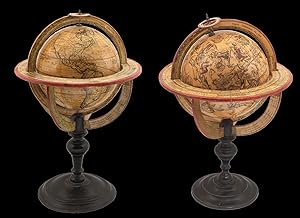A propos de cet article
"Ingenieur-Mechanicien pour les Globes et Spheres" A pair of terrestrial and celestial globes, each with 12 hand-coloured engraved paper gores over papier mâché and plaster sphere, varnished, paste-board meridian ring, wooden horizon ring, raised by four quadrant supports, mounted on an ebonized turned wood table stand. Together with an armillary sphere, containing globe with 12 hand-coloured engraved gores, over a papier mâché and plaster sphere, varnished wood, raised on four quadrant supports, with ebonised turned wood table stand. Biography Jean Fortin (1750-1831) was a scientific instrument-maker born in Picardy, France. Chiefly remembered for designing a barometer that ensured more accurate readings, he also produced celestial atlases, scales and was commissioned by the French royal family to make globes. He made terrestrial and celestial globes of 320 and 220mm (12 and 8.75 inches) diameter, as well as a terrestrial globe of 55mm (2.25 inches) to go into his armillary spheres. Fortin operated in Paris, with a shop in the Rue de la Harpe, where he referred to himself as "Ingenieur-Mecanicien pour les Globes et Spheres". He is also known for publishing the new celestial atlas of John Flamsteed (1646-1719) in 1762, which was highly influential as a source for celestial cartography throughout the rest of the century. His business was continued by his son Augustin, grandson Michel and great-grandson Augustin. Geography The prime meridian, which runs through the Canary Islands at Ferro, the equator, and the ecliptic are all graduated and labelled. The ecliptic includes the signs of the zodiac. Australia and New Zealand are drawn according to the discoveries of Abel Tasman; a dotted line marks a hypothetical northeast, east, and south coast of Australia. There are no tracks of voyages shown, but the lands seen by Quiros and David are marked. The two demi-meridian rings mark the latitude and longitude of the major cities of the world. North America extends almost to the north pole, and is apparently attached to Asia in the west and Greenland in the east. However, California is shown as a peninsula. Astronomy The equator is graduated and labelled "Cercle de L'Equateur" and "Cercle Equinoctial". The ecliptic is graduated; it is labelled "Ligne Eclipt" and "la Zodiaque" and provided with the symbols of the signs of the zodiac. There are labels for the "Artique" along the north polar circle "the Tropique de Capricorn", "the Tropique de Cander", "the Pol. d'eclipt. Australle", "the Colure des Aequinoxe" and "the Colure des Solstique". There is a magnitude table which is labelled "Gr. et Figure des Etoilles". The 48 Ptolemaic constellations are shown as well as the non-Ptolemaic constellations Antinous, La Chevelure de Berenice, La Croix, and La Colombe. The 12 southern constellations of Plancius are depicted. Armillary The Ptolemaic armillary sphere shows the cosmos with the earth at its centre. The complex device is made of moving circles: a meridian surmounted by an hour circle with metal pointer and an internal ring structure of polar circles, tropics and equator, joined by an equinoctial and a solstitial colure and surrounded by a planar zodiac band. These elements surround a rotating terrestrial globe, and a revolving sun and moon of flat paste-board discs, horizon band with calendar and zodiac. The four quadrant supporting the horizon ring give the latitude and longitude of major cities throughout the world.
N° de réf. du vendeur 15693
Contacter le vendeur
Signaler cet article
